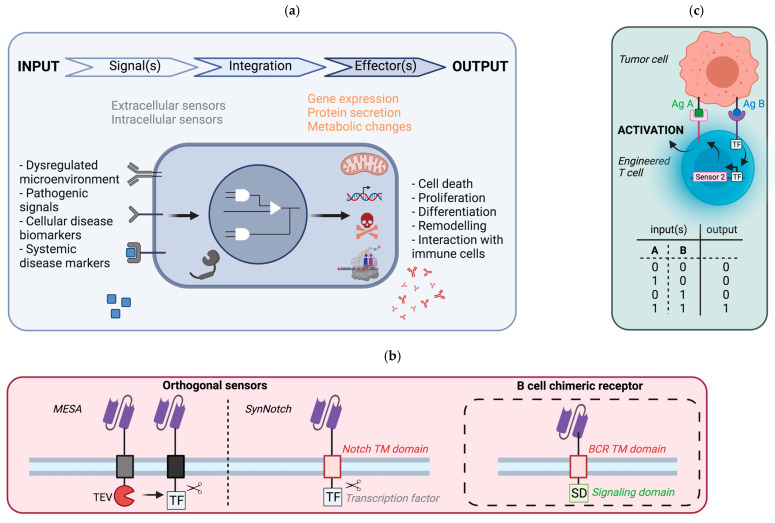Figure 3.
Synthetic immunology approaches applicable to B cell therapies. (a) General principle of synthetic regulatory networks. A disruption of homeostasis, such as a local dysregulation, the presence of pathogenic motifs or disease biomarkers, can be recognized by dedicated sensors. These sensors transduce the signals by signaling pathways. Depending on the circuit architecture, several signals may be computed to generate different responses depending on the signal strength and/or the combination of signals detected (gene expression, metabolic changes). (b) Chimeric synthetic sensors transposable for the regulation of synthetic networks in B cells. The MESA approach relies on two sensors, both having ScFv domains for target recognition and the CD28 transmembrane domain, but differing in their intracellular parts: one contains the TEV protease, while the other harbors a TEV cleavage site before an ectopic transcription factor. Upon the binding of the target antigen, the transcription factor is released by cleavage on the TEV site. Similarly, the SynNotch sensor is composed of ScFv fragments for the recognition of the target, and fused to the transmembrane domain of the Notch receptors linked to an ectopic transcription factor (middle). Upon the binding of the antigen, a mechanical force triggers the release of the orthogonal transcription factor (the Notch receptor is naturally cleaved after the binding with its ligand Delta), which activates the transcription of a transgene inserted under the control of a promoter sensitive to this transcription factor (ectopically provided). Chimeric BCR sensors combine the extracellular ScFv fragments (for recognition) and the BCR transmembrane regions fused to the intracellular of the Igb (CD79b) signaling domain (right). (c) AND-gate circuit regulation. Complex circuits with Boolean gates have been developed to refine the response depending on several input cues. An AND-gate has been developed to trigger T cell activation only if two tumor antigens are detected. When the first sensor, constitutively expressed, recognizes the antigen A, it triggers the expression of the second sensor that recognizes the antigen B, and this second recognition leads to T cell activation.

